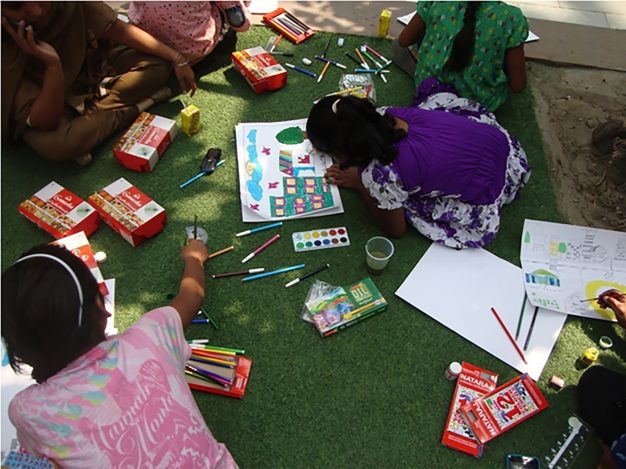
Reimagining Indian cities for the youngest residents
Cities can work to enhance access to public parks, gardens and open spaces, with dedicated and semi-dedicated areas for young children that incorporate natural, play and sensory stimulants.
The COVID-19 pandemic is testing the capability of cities to provide for their citizens. While all age groups have been impacted, young children, aged 0 to 5, are the most affected due to dependency on their caregivers who are predominantly women and the elderly – many of whom are unable to access essential health services, public spaces and transport. According to the 2011 census, 13 per cent of India’s population comprises children in the age bracket of 0 to 6 years.
Our cities have historically focused on catering to the working population and they are not the most welcoming to their vulnerable inhabitants — i.e. the very young. The infrastructure in Indian cities is focused on building business districts and faster roads but open spaces, parks and safe streets around schools are yet to become urban design priorities, write Rushda Majeed, India Representative, Bernard van Leer Foundation, and OP Agarwal, CEO, World Resources Institute India.
In recent years, the Government of India has championed several policies targeting women and child welfare, be it in nutrition (POSHAN Abhiyaan), protection of the girl child (Beti Bachao, Beti Padhao), penetration of LPG connection, provision of toilets, and leveraging technology and skill-building among others. While these efforts are laudable, the policymaking focus could be expanded to include urban infrastructure and public spaces that enable a better quality of life for infants, toddlers, their mothers and other caregivers. Recently, the Ministry of Housing and Urban Affairs (MoHUA) announced the Nurturing Neighbourhoods Challenge – an initiative aimed at supporting and developing cities that are responsive to the needs of very young children and their families.
Why 0–5 years?
Global evidence suggests that the investment made in the first 1000 days of a child’s life is most critical and foundational for his/her holistic wellbeing. The brain develops at its most rapid pace in the first five years of life, with one million new neural connections being formed per second. Healthy brain development, therefore, requires that children have adequate nutrition, opportunities to learn, nurturing care from caregivers, and a safe environment. Access to natural green spaces and other safe and stimulating environments with opportunities to play and learn in the early years becomes vital—both for the young child and his/her family so they can nurture and support the child better. This, in turn, translates into better adult health outcomes, greater ability to learn, and higher lifetime incomes for the child.
Cities for young children are cities for all
Babies and toddlers are dependent on their caregivers, and together the baby and her mother (or father) are also the most vulnerable users in the public domain as they experience the city as one unit. Enrique Penalosa, the former Mayor of Bogota, has rightly said, “Children are a kind of indicator species, if we can build a successful city for children, we will have a successful city for everyone.” Focusing on young children and their caregivers — parents, grandparents or elder siblings — is therefore one of the most efficient and comprehensive ways to improve the urban environment for everyone. Efforts to improve city infrastructure to ensure safety and access, by placing infants, toddlers and caregivers at the centre, will not only increase usage by families of young children, and make young children more likely to develop to their full potential, but also help make the city better for everyone.
What children-centric urban planning entails
Child-centric urban planning is much more than just building playgrounds. Cities need to start considering neighbourhoods, within walking distance from homes, as an important geographical unit as young children and their caregivers spend most of the time there. The COVID-19 pandemic further underlines the importance of the neighbourhood as a community space. Indeed, it takes a neighbourhood to raise a healthy child. Urban designing efforts need to focus more on creating child-friendly spaces that welcome the very young and their mothers/caregivers. Cities can undertake simple solutions to simulate improvements without major cost implications. These could include:
· Walkable streets
Streets are not just for mobility; they are also public spaces that inspire engagement. Along with ensuring the safe and comfortable non-motorised movement of young children and their caregivers, by improving pedestrian infrastructure, city planners can also look at incorporating playful spaces and interactive installations. Using traffic calming techniques as a tool to combat speeding and making streets more inclusive are other key considerations.
· Engaging public spaces
Cities can work to enhance access to public parks, gardens and open spaces, with dedicated and semi-dedicated areas for young children that incorporate natural, play and sensory stimulants along with offering caregivers the opportunity to engage in social and physical activities.
· Early childhood amenities
When a young mother feels safe and confident in nursing her child in a public space, it is a sign that the proper infrastructure to meet her needs has been designed and installed. Amenities such as nursing cabins, gender-sensitive restrooms, shaded areas, signage, and clean drinking water, in public spaces like bus stops, terminals, markets etc., improve the urban experience for everyone.
· Access to early childhood services
Cities can improve access to early childhood facilities such as anganwadis and public health centres through better mobility options and by improvements in surroundings — such as integrating areas to play and rest and clustering of young children-oriented functions.
The emphasis on urban infrastructure will gain momentum in the coming years. There should be many such initiatives that are inclusive, guided not just by additional budgetary provisions, but rather by intentional efforts to make cities more caring.
(Rushda Majeed is India Representative, Bernard van Leer Foundation. OP Agarwal is CEO, World Resources Institute India. Views are personal.)
Originally published by Times Now News of India.




